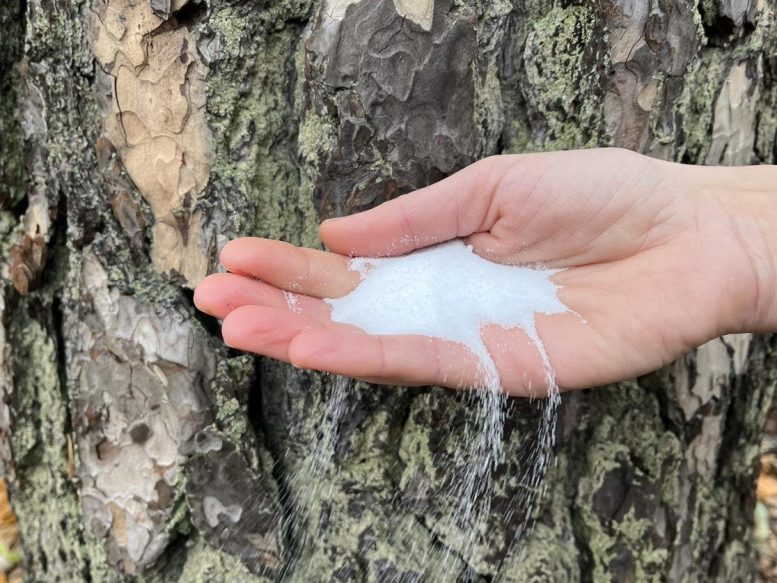
Sodium-ion batteries contain sodium – a very common substance found in table salt – instead of lithium. Credit: Chalmers
As society shifts away from fossil fuels, the demand for batteries is surging. Concurrently, this surge is likely to lead to a scarcity of lithium and cobalt, essential elements in prevalent battery types. An alternative solution could be sodium-ion batteries, which primarily utilize table salt and biomass derived from the forestry sector as their raw materials.
Now, researchers from Chalmers University of Technology, Sweden, show that these sodium-ion batteries have an equivalent climate impact as their lithium-ion counterparts – without the risk of running out of raw materials.
“The materials we use in the batteries of the future will be important in order to be able to switch to renewable energy and a fossil-free vehicle fleet,” says Rickard Arvidsson, Associate Professor of Environmental Systems Analysis at Chalmers.
According to the European Commission’s Critical Raw Materials Act, the demand for critical raw battery materials is expected to increase exponentially as EU countries transition to renewable energy systems and electric vehicles. The green transition will also require more local production of batteries and other new fossil-free technologies, and a steady supply of raw materials is needed to meet demand. At the same time, such production carries a high risk of supply disruptions, due to the limited number of sources for raw materials.
“Lithium-ion batteries are becoming a dominant technology in the world and they are better for the climate than fossil-based technology is, especially when it comes to transport. But lithium poses a bottleneck. You can’t produce lithium-based batteries at the same rate as you want to produce electric cars, and the deposits risk being depleted in the long term,” says Rickard Arvidsson. In addition to this, critical battery materials, such as lithium and cobalt, are largely mined in just a few places in the world, posing a risk to the supply.
Sodium-ion batteries offer promising technology
The development of new battery technologies is moving fast in the quest for the next generation of sustainable energy storage – which should preferably have a long lifetime, have a high energy density, and be easy to produce. The research team at Chalmers chose to look at sodium-ion batteries, which contain sodium – a very common substance found in common sodium chloride – instead of lithium. In a new study, they have carried out a so-called life cycle assessment of the batteries, where they have examined their total environmental and resource impact during raw material extraction and manufacturing.

Rickard Arvidsson, Associate Professor, Department of Technology Economics and Management, Chalmers University of Technology, Sweden. Credit: Chalmers
“We came to the conclusion that sodium-ion batteries are much better than lithium-ion batteries in terms of impact on mineral resource scarcity, and equivalent in terms of climate impact. Depending on which scenario you look at, they end up at between 60 and just over 100 kilograms of carbon dioxide equivalents per kilowatt hour theoretical electricity storage capacity, which is lower than previously reported for this type of sodium-ion battery. It’s clearly a promising technology,” says Rickard Arvidsson.
The researchers also identified a number of measures with the potential to further reduce climate impact, such as developing an environmentally better electrolyte, as it accounted for a large part of the battery’s total impact.
Green energy requires energy storage
Today’s sodium-ion batteries are already expected to be used for stationary energy storage in the electricity grid, and with continued development, they will probably also be used in electric vehicles in the future.
“Energy storage is a prerequisite for the expansion of wind and solar power. Given that the storage is done predominantly with batteries, the question is what those batteries will be made from? Increased demand for lithium and cobalt could be an obstacle to this development,” says Rickard Arvidsson.
The major advantage of the technology is that the materials in the sodium-ion batteries are abundant and can be found all over the world. One electrode in the batteries – the cathode – has sodium ions as a charge carrier, and the other electrode – the anode – consists of hard carbon, which in one of the examples the Chalmers researchers have investigated can be produced from biomass from the forest industry. In terms of production processes and geopolitics, sodium-ion batteries are also an alternative that can accelerate the transition to a fossil-free society.
“Batteries based on abundant raw materials could reduce geopolitical risks and dependencies on specific regions, both for battery manufacturers and countries,” says Rickard Arvidsson.
More about the study
The study is a prospective life cycle assessment of two different sodium-ion battery cells where the environmental and resource impact is calculated from cradle to gate, i.e. from raw material extraction to the manufacture of a battery cell. The functional unit of the study is 1 kWh theoretical electricity storage capacity at the cell level.
Both types of battery cells are mainly based on abundant raw materials. The anode is made up of hard carbon from either bio-based lignin or fossil raw materials, and the cathode is made up of so-called “Prussian white” (consisting of sodium, iron, carbon, and nitrogen). The electrolyte contains a sodium salt. The production is modeled to correspond to a future, large-scale production. For example, the actual production of the battery cell is based on today’s large-scale production of lithium-ion batteries in gigafactories.
Two different electricity mixes were tested, as well as two different types of so-called allocation methods – that is, allocation of resources and emissions. One where the climate and resource impact is distributed between coproducts based on mass, and one method where all impact is allocated to the main product (the sodium-ion battery and its components and materials).
Reference: “Prospective life cycle assessment of sodium-ion batteries made from abundant elements” by Sanna Wickerts, Rickard Arvidsson, Anders Nordelöf, Magdalena Svanström and Patrik Johansson, 13 November 2023, Journal of Industrial Ecology.
DOI: 10.1111/jiec.13452
The study was funded by the Swedish Energy Agency through the Battery Fund Program.









Green salt batteries, good news. We have lots of salt, and less lithium. It might make recycling the battery possible, where it’s not yet feasible with lithium batteries.
I mostly wanted to say that the photo used, with a hand salting a tree for some reason, kills plants, and enough salt will kill that tree. Lithium probably wouldn’t, unless it’s a Tesla on Autopilot hitting the tree.
Study: Salton Sea area could produce enough lithium for 375 million electric car batteries. The hot brine located in a vast underground reserve beneath the Salton Sea likely contains enough lithium to build batteries for 375 million electric vehicles, according to a new report released Tuesday
Sodium batteries energy to weight ratio not as good as lithium. Charge cycle life not as good as lithium but better fire or explosion safety than lithium. Anyway batteries become perfect only in hybrid modes. The best hybrid mode is green hydrogen.
Cheap and easy are two words that the automakers don’t want to hear, they want, bring it in and we’ll repair.
Pls more information